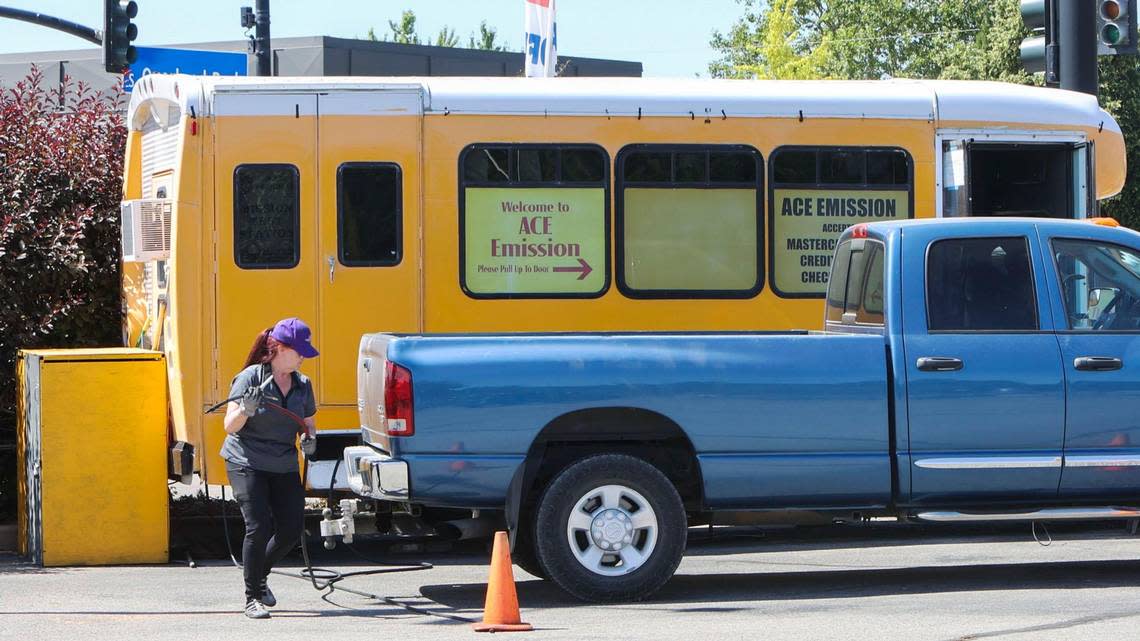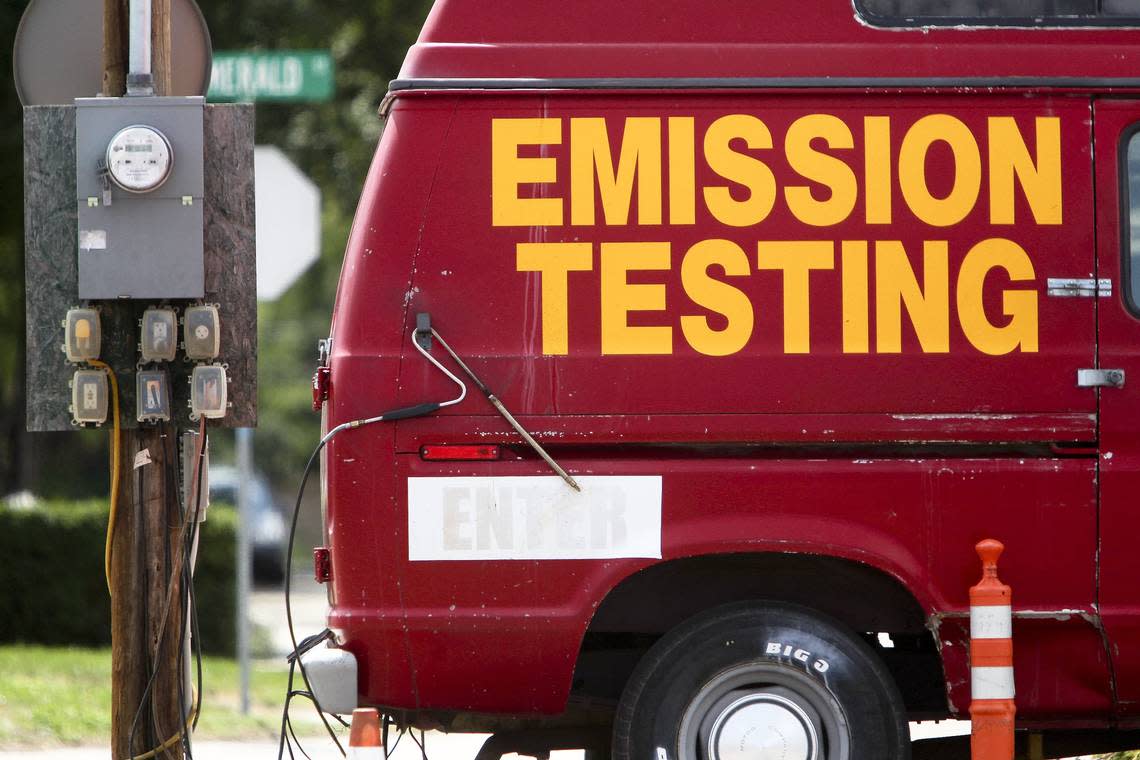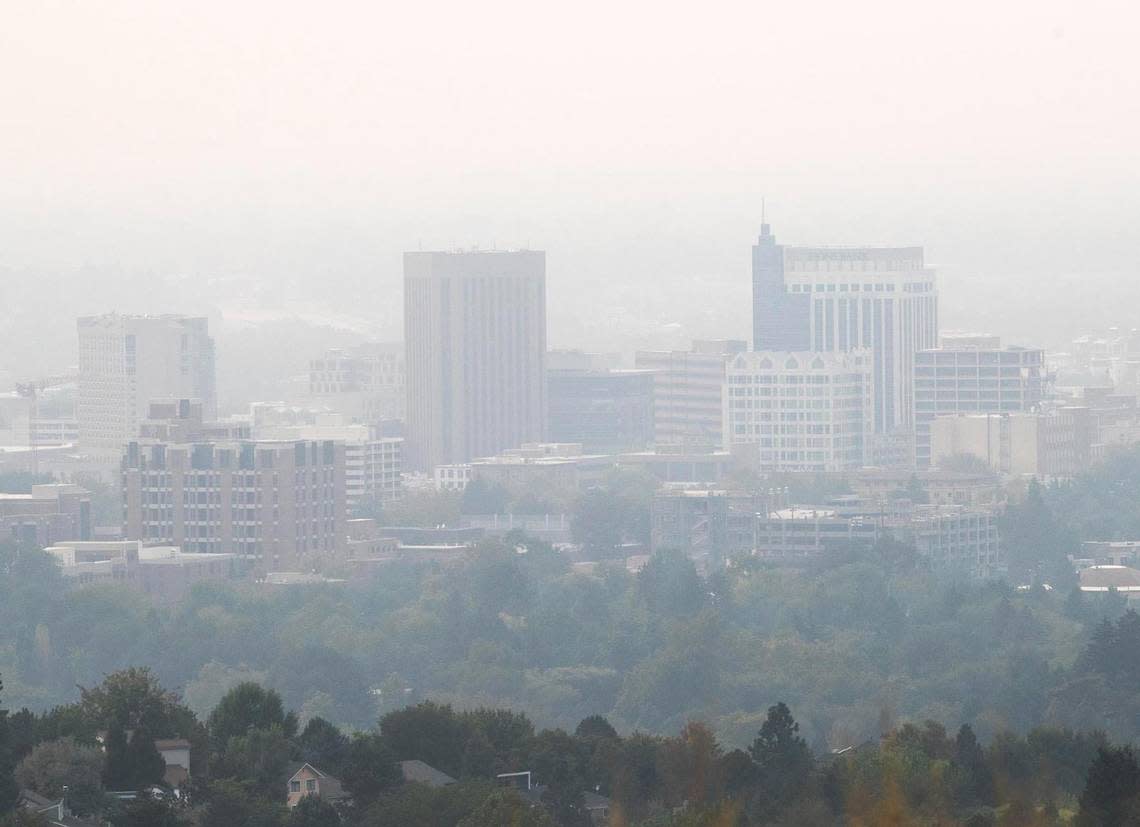Idaho wants to end vehicle emissions testing. How will that affect you — and our air?
After years of compliance, the Idaho Department of Environmental Quality wants to get rid of Ada County’s emissions testing program, claiming the usefulness of the program has run out.
Following the passage of a bill in the Idaho Legislature that will remove emissions testing programs in Kuna and Canyon County, the department plans to ask the federal government to remove the requirement for Ada County. If the Environmental Protection Agency agrees, Ada County cities will consider what to do with their vehicle testing requirements.
In March, the Legislature voted to strike an emission testing requirement put in place decades ago after the region’s air quality violated federal standards.

Since then, Treasure Valley air quality has markedly improved, and the area has been in compliance for 36 years, according to DEQ. A combination of the testing requirements and advances in vehicle technology have caused the improvement, said Patrick Bageant, a Boise City Council member and a member of the region’s Air Quality Board, which oversees the testing program.
“In the abstract, being in a position where we can lift a maintenance plan for carbon monoxide is a good thing,” Bageant told the Idaho Statesman by phone.
He added that it isn’t clear how effective the testing program is, given that a large percentage of vehicles pass. About 92% of vehicles in Ada County now pass on the first try, according to the Community Planning Association, or Compass, which manages the daily operations for the Ada County Air Quality Board.
The emissions testing program in Ada County began as a result of a carbon monoxide violation of the National Ambient Air Quality Standards in 1986, said Michael Hahn, vehicle emissions coordinator for the Idaho Department of Environmental Quality. But the Valley has been in compliance for three decades with all of the standards.
The emissions testing program in Canyon County and Kuna began in 2010 because of an Idaho law that required vehicle emissions tests in airsheds where an ambient air pollutant is at or above 85% of the maximum allowed by the standards. The Idaho Legislature removed that requirement in the March vote— it take effect July 1, 2023. According to DEQ, the Treasure Valley airshed is below the 85% standard, but because of its violation in 1986, the EPA must authorize the removal of the emissions program in Ada County.
When the state implemented its testing plan to comply with the EPA requirements, it delegated the project to local municipalities to carry out, said Amy Luft, a spokesperson for Compass.
The National Ambient Air Quality Standards, set by the EPA, also include five other pollutants: lead, nitrogen dioxide, ozone, particle pollution and sulfur dioxide.
Ada County was also in violation of the particle pollution standard, but is now compliant with all the standards, Hahn said.
Emissions tests for older cars monitor the emissions of carbon monoxide and hydrocarbons coming from the vehicle. The tests for newer cars check to make sure emissions-control devices are working. Evolving federal requirements and resulting technological improvements have caused most vehicles that are functioning properly to not need the tests.
Vehicles that fail can also apply for waivers, depending on the circumstances. Hybrid vehicles, and those that are less than four years old or were made before 1981, are exempt, according to the board’s website. Motor vehicles with a model year older than 1981 are exempt from testing, according to the department.
This fall, DEQ plans to petition the EPA to remove the emissions testing requirement. The department said it is working on that now, Hahn said.

The department must demonstrate to the EPA that without emissions testing, Ada County will continue to comply with the national standards.
The EPA will likely accept or reject the petition in June of next year, Hahn said by email. The Idaho law change would go into effect a month later.
A similar emissions check program ended in Washington in 2020 and in Tennessee last year.
Municipalities consider changing ordinances
On June 21, the Meridian City Council said that if the EPA accepts the petition to end emissions testing, Meridian would likely remove its ordinance requiring testing. The council said if air quality experts are suggesting an end to emissions testing, the city would have no reason to continue the program and would have to operate emissions testing requirements itself.
The Ada County Air Quality Board asked the council for guidance as it begins to work through its annual budget cycle. If cities planned to keep their ordinances, that would change some operations for the board, said Laurelei McVey, director of public works for Meridian and member of the Air Quality Board.
“If emissions testing is removed, there will be no negative impact on Treasure Valley air quality,” said McVey in her presentation to the council. “We see periods of lower-than-desired air quality, but vehicle emissions concerns will not help that.”
Poor air quality in the Valley results from more vehicles on the roadway, wood stove smoke and wildfire smoke, said Matt Stoll, the executive director of Compass.

“(DEQ is) not saying that controlling emissions is not important, they are saying the emissions testing program may have outlived its purpose,” said Stoll.
In Boise, the City Council will – at some point – review its ordinance too, Bageant said.
“There’s a little bit of limbo while we wait for the DEQ and the EPA, and then there’s a window of time after that to look at what they have to say, look at the science, listen to what the citizens want,” he said.
Bageant said the decisions of municipalities should not be made based on politics.
“The science of air quality and the science of pollution is science, and it should be kept at the level of science,” he said. “If the Idaho State Legislature (and) Joe Biden’s EPA agree on something, it’s probably because it’s true.”
Gary Richardson, a 40-year Ada County resident and former Ada County Highway District commissioner, has been interested in air quality and emissions throughout his time in Idaho. He remembers in the 1970s when Boise had “a serious problem with inversions.”
In the Treasure Valley, temperature inversions mostly happen in the winter. Cold air is trapped in the Valley, with warmer air above, an inversion of the norm. Inversions trap stagnant air near the ground, and it gathers pollutants.
In the summer, wildfire smoke from as far as hundreds of miles away can blow through the state, also fouling the air.
As the region’s population grows, more people and vehicles are coming to town.
In the ‘70s, “the real issue was carbon monoxide emission,” said Richardson by phone. “That was pretty well taken care of by the engine standards that the EPA implemented.”
But now, Richardson agrees that the emissions tests are obsolete.
“I’m not too concerned, because I think most of the problems are related to stuff that wasn’t really being measured by emissions tests,” he said.
How does this affect other pollutants?
The Idaho Conservation League, an environmental group, opposed the Legislature’s bill, citing concerns about ozone connected with population growth.
Monitoring carbon monoxide, nitrogen oxides and volatile organic compounds – as emissions tests do – helps reduce ozone in the atmosphere, the group said in a post on its website.
Earlier this year, Tiffany Floyd, head of the DEQ’s air quality division, reported that the state is above 85% of the National Ambient Air Quality Standards for ozone, which puts the area in a “buffer zone” that could soon turn into violations, according to previous Statesman reporting.
In the upper atmosphere, ozone helps protect life on Earth from harmful ultraviolet radiation. But close to the surface, ozone can cause health problems, according to the EPA.
The emissions tests are “one of the few tools we have to keep our air healthy and clean,” the Idaho Conservation League post said.
The Idaho Association of Commerce and Industry, a major lobbying group, supported the bill.
Richardson suggested that perhaps California’s requirement that gas stations upgrade their fuel pump nozzles to reduce the emissions of volatile organic compounds while filling up the gas tank could be implemented in the Valley. According to the California Air Resources Board, gasoline vapors released when you fill your tank react with other pollutants to form ozone.
Hahn said DEQ still plans to work with local communities to identify emissions problems and protect air quality if the emissions-testing requirement is revoked.
Bageant said removal doesn’t preclude future pollution requirements from being established.
“We always need to be flexible and adaptable and aware that whatever decisions are made are never the final decisions … Air quality may require different interventions in the future,” Bageant said.
“The goal of everybody, I think, in the Treasure Valley is clean air,” he said. “That’s certainly what the citizens want.”
WeatherWhys: This is what makes air quality poor. Here’s how it can affect your health
Are electric vehicles worth it in Idaho? As gas prices surge, EVs may be the answer
